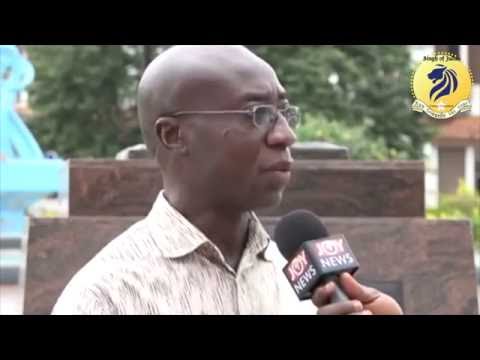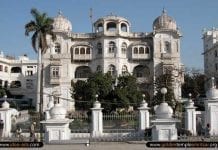1. San Francisco, California (2010)
A local on-scene reporter stated: “This is Thalia Gigerenzer from the Bay Citizen, and I’m here at the Gandhi protest on Gandhi’s birthday at the Ferry Building.”
Protestor Bhajan Singh said: “We are the victims of the generations as the result of his policies which led to one million people killed in 1947.”
Protestor Pieter Friedrich said: “Gandhi was extremely racist towards black people in South Africa.”
2. Flint, Michigan (2010)
An ABC12 Flint anchor reported: “Not everybody’s in favor of what Gandhi stood for.”
“Community peace organizers,” stated an on-scene reporter, “marched to Wilson Park to unveil this statue as a symbol of universal peace. Though protestors across the street against the statue stood by to express why they believe Gandhi was not as saintly as many claim.
Protestor Raj Kamble said: “Over 250 million people, even today, suffer because of Gandhi’s policies. He was against the humanity. Against equality.”
3. Cerritos, California (2013)
Speaking at a Cerritos City Council meeting, Protestor B.J. Singh said: “Good evening, Mayor and Councilmembers, and thank you for the opportunity to come and speak here with you. I’d like to you about the Gandhi statue on the corner of Bloomfield and Alondra. A book was published — it was called ‘Freedom at Midnight’. The book put out about Gandhi, about his own personal morality, about his pedophilic or sexual predatory character. If a person of that character was in the U.S. and he did the things that he did, he would be in prison. I don’t think a statue of Gandhi sends a good message about our city.
Protestor Bhajan Singh said: “The reputation of Cerritos as Little India spreads throughout America. I’m going to leave you all the facts right here. You promoted a piece of racial hatred, you are promoting sexual exploitations, you are promoting violence, you are promoting a friend of Hitler, and this is totally un-American. This does not fit. Not only in Cerritos — it doesn’t fit anywhere.”
Protestor Pieter Friedrich said: “Gandhi was an advocate of racial segregation in pre-apartheid South Africa. Gandhi was also a man who, late into his 70’s, forced his 18-year-old grandniece Manu and his 17-year-old grandniece Abha to sleep naked with him on a nightly basis to ‘test’ his commitment to celibacy. A little discernment may have been helpful in considering which South Asian should be honored with a statue in Cerritos.”
4. Fresno, California (2013)
Protestor Jada Bernard said: “In the middle of this peace garden, we see a statue to Gandhi. And on Gandhi’s, it says: ‘My life is my message’. This is not from his Nobel Peace Prize acceptance speech because he was rejected five times for it. He participated in every major war of his lifetime. He was divisive, racist, and classist — oppressive even toward his own people. The statue says his life is his message, and that is the sad part, because his life is something that has not been told correctly.”
5. Johannesburg, South Africa (2015)
A NewsX anchor reported: “They were bearing placards reading: ‘Racist Gandhi must fall.’ As you can see, the father of the nation, his statue has been desecrated in South Africa. Mahatma Gandhi, of course, spent a lot of his early years as a lawyer in Johannesburg. A PTI correspondent from South Africa is joining me on the phone-lines.”
PTI Correspondent Faqir Hasan stated: “There’s also been a movement trying to prove that Gandhi was racist. You know, in his early writings he spoke using derogatory terms for black people.”
6. Davis, California (2016)
A CBS13 Sacramento anchor reported: “A proposed statue of Mahatma Gandhi is now causing controversy in the city of Davis.”
Protestor Dr. Gurbaksh Singh Bagha said: “I 100% oppose it.”
Davis Vice-Mayor Brett Lee said: “They seem to have really heartfelt, sincere concerns about the statue.”
“No statue,” said protestor Bhajan Singh. “We oppose the statue.”
CBS13 reported: “Opponents accuse Gandhi of having a dishonorable history of racism and abuse that is not well known, and they say he is not an appropriate role model.”
Speaking at a Davis City Council meeting, protestor Amar Singh Shergill stated: “But he was also a bigot, and he also was a predator on members of his own family — young women, and he also institutionalized caste. He helped create an institutionalized apartheid in South Africa.”
Another protestor said: “So I am very much against to locate the statue of the Gandhi in the Davis city.”
Yet another protestor said: “So I don’t like Gandhi’s statues.”
Dr. Bagha concluded: “So I duly oppose Gandhi’s statue in U.C. Davis.”
7. Accra, Ghana (2016)
An anchor for Pulse TV reported: “Academics at the University of Ghana are demanding a statue of Gandhi be pulled down. The statue glorified a man who was uncharitable in his attitude toward the black race, and allowing it to remain makes the university appear to hold double standards.”
An anchor for Joy News interviewed Dr. Kwadwo Appiagyei, who said: “But we think that there is a problem with the statue in the sense that Gandhi has a racist past. And in a situation or an environment where we champion the cause of equality — racial equality — I don’t think that this statue has a place here. But the racist past is what we think should be exposed for the world to know, because there seems to be a gloss over that aspect of his life. As long as it affects blacks, especially when he lived in South Africa.”
Gathering in support of the movement in Ghana, Indian-Americans recorded a video message to the University of Ghana, with their spokesman stating: “My name is Dr. Gurbaksh Singh Bagha. I am Sacramento, California. And this message is to convey to Ghana University officials that they have installed Gandhi’s statue in Ghana, and it is very shocking that Gandhi was racist, he was pedophilic, he dehumanized Africans and treated them less than animals. And still they put the statue in the university. We request you to remove the statue to give remove the statue to give justice to the African people from Ghana University. Thank you very much. I hope you listen. Thank you very much. Appreciate.”
In conclusion, speaking to the Cerritos City Council in 2013, B.J. Singh explained: “The only thing that keeps you from taking any action is, I think, the lack of knowledge — extensive knowledge — of Gandhi.”






Read about Gandhi’s racism here —
http://www.gandhism.org
It’s strange that Mr. Willey suggests people read Gandhi’s propaganda autobiography, written for public relations purposes. What about Gandhi working as a lawyer to demand Africans be segregated from Indians? What about Gandhi’s writings that explicitly protest Indian children having to share a school with African children? What about his newspaper articles insisting that Indians should support the British Empire’s slaughter of Zulus during the Bambata Rebellion because, he said, “the white race of South Africa should be the predominating race”? What about how his newspaper called on Indians to donate money and supplies to support the British Army’s war effort against the Africans? What about his diary accounts during the war in which he records fearing the Zulus, trying to get the British to allow weapons to the Indians so they could join the fight, and helping only wounded British soldiers — and not a single Zulu — which makes sense since he volunteered to become a British soldier in a colonial war against indigenous people?
The charges of racism, institutionalized caste building, and sexual abuse against Gandhi are being promoted by people who have taken snippets of Gandhi’s words, out of context, and applied them to the contexts that they are presently in now, decades later, distorting history as they prance along. Please see my open letter to Arundhati Roy, here:
https://www.transcend.org/tms/2015/01/an-open-letter-to-arundhati-roy-by-an-american/
Although it is an oxymoron to say one is a Gandhian scholar, I have spent over 30 years of my life studying Gandhi’s thought, and seeking to understand my own relationship to the ideals he gave humanity a vision of. In the last several years there has been an unfortunate and ignorant effort to portray Gandhi as racist among other things. Gandhi evolved to the ideals that he place before humanity in an unending experiment throughout his entire life. Regarding the most recent deliberate mis handling of Gandhi in Ghana University, I would like to ask:
Are the students and faculty aware that Gandhi had his house in S. Africa built according to native architecture, the Kraal, Would a racist person want anything to do with native architecture?
Are they aware that the “ambulance corp’ Gandhi made with other colonialized Indians, was the only succor for wounded Zulus in the horrific Zulu War of Independence (Bambata Rebellion)? (Have they experienced personally the devastating effects of growing up under colonialism upon the psyche?) White military refused to touch them after mortally wounding them. Gandhi was grateful to be able to be of service to them. Is that a racist attitude?
Are the students aware that Gandhi and Tagore jointly called for all Indians in Africa to educate their children along with Africans?
The students should be encouraged to read Gandhi’s “Story of My Experiments with Truth” and critically examine what they are hearing, and what they have learnt. They might likewise examine the structures and directions that their present education is taking them, for whose profit, and to what ends? They might find in Gandhi’s work for the poor of India, solutions to the real problems of Ghana. Nelson Mandela and Desmond Tutu made a deep study of Gandhi’s life, and never came to such shallow conclusions.